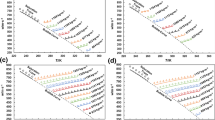Abstract
Speed of sound data measured using a dual-path pulse-echo instrument are reported for three binary refrigerant mixtures, R-125/1234yf, R-1234yf/152a, and R-1234ze(E)/227ea, at compositions of (0.33/0.67) and (0.67/0.33) mole fraction. The speed of sound was studied at temperatures ranging from 230 K to 345 K from pressures slightly above the bubble point curve up to 20 MPa for the mixtures containing R-1234yf and 49 MPa for the R-1234ze(E)/227ea mixtures. The relative combined expanded speed of sound uncertainty ranged from 0.039 % to 0.317 % with a mean uncertainty over all state points of less than 0.10 %. The reported data are compared to the most recent mixture models in REFPROP for each blend studied. Comparisons of available mixture models for the R-125/1234yf and R-1234yf/152a blends exhibit average absolute deviation values ranging from 0.10 % to 0.27 %, and the average absolute deviations for R-1234ze(E)/227ea blends range from 0.62 % to 0.94 %. The comparisons show that only minor adjustments are required to the R-125/1234yf and R-1234yf/152a mixture models to represent the speed of sound data within its uncertainty. However, significant adjustments are needed to improve the current mixture models for the R-1234ze(E)/227ea blend. Deficiencies with the R-1234ze(E)/227ea mixture model are not unexpected since it (1) utilizes a pure-fluid EOS R-1234ze(E) that has been shown to inaccurately represent R-1234ze(E) speed of sound values and (2) uses binary interaction parameters for the chemically similar mixture of R-1234yf/227ea.


Similar content being viewed by others
References
S.L. Outcalt, A.J. Rowane, Bubble point measurements of mixtures of HFO and HFC refrigerants. J Chem Eng Data 66, 4670–4683 (2021)
S.L. Outcalt, A.J. Rowane, Bubble point measurements of three binary mixtures of refrigerants: R-32/1234yf, R-32/1234ze(E), and R-1132a/1234yf. J Chem Eng Data 67, 932–940 (2022)
A.J. Rowane, R.A. Perkins, Speed of sound measurements of binary mixtures of difluoromethane (R-32) with 2,3,3,3-tetrafluoropropene (R-1234yf) or trans-1,3,3,3-tetrafluoropropene (R-1234ze(E)) refrigerants. Int J Thermophys 43, 46 (2022)
A.J. Rowane, R.A. Perkins, Speed of sound measurements of binary mixtures of 1,1,1,2-tetrafluorethane (R-134a), 2,3,3,3-tetrafluoropropene (R-1234yf), and trans-1,3,3,3-tetrafluoropropene (R-1234ze(E)) refrigerants. J Chem Eng Data 67, 1365–1377 (2022)
I.H. Bell, Mixture models for R-1234yf/134a, R-1234yf/1234ze(E), and R-134a/1234ze(E) and interim models for R-125/1234yf, R-1234ze(E)/227ea, and R-1234yf/152a. J Phys Chem Ref Data 51, 013103 (2022)
E.W. Lemmon, I.H. Bell, M.L. Huber, M.O. McLinden, NIST Standard Reference Database 23: Reference Fluid Thermodynamic and Transport Properties-REFPROP, Version 10.0 (Gaithersburg, MD, National Institute of Standards and Technology, 2018)
E.W. Lemmon, R. Akasaka, An international standard formulation for 2,3,3,3-tetrafluoroprop-1-ene (R1234yf) covering temperatures from the triple-point temperature to 410 K and pressures up to 100 MPa. Int J Thermophys 43, 119 (2022). https://doi.org/10.1007/s10765-022-03015-y
M. Thol, E.W. Lemmon, Equation of state for thermodynamic properties of trans-1,3,3,3-tetrafluoropropene [R-1234ze(E)]. Int J Thermophys 37, 28 (2016)
E.W. Lemmon, R. Span, Thermodynamic properties of R-227ea, R-365mfc, R-115, and R-1311. J Chem Eng Data 60, 3745–3758 (2015)
E.W. Lemmon, R.T. Jacobsen, A new functional form and new fitting techniques for equations of state with application to pentafluoroethane (HFC-125). J Phys Chem Ref Data 34(1), 69–108 (2005)
S.L. Outcalt, M.O. McLinden, A Modified Benedict-Webb-Rubin equation of state for the thermodynamic properties of R-152a (1,1-difluoroethane). J Phys Chem Ref Data 25, 605 (1996)
I.H. Bell, E.W. Lemmon, Automatic fitting of binary interaction parameters for multi-fluid Helmholtz-energy-explicit mixture models. J Chem Eng Data 61, 3752–3760 (2016)
I.H. Bell, D. Riccardi, A. Bazyleva, M.O. McLinden, Survey of data and models for refrigerant mixtures containing halogenated olefins. J Chem Eng Data 66(6), 2335–2354 (2021)
M.O. McLinden, R.A. Perkins, A dual-path pulse echo instrument for speed of sound of liquids and dense gases and measurements on p-xylene and four halogenated-olefin refrigerants [R1234yf, R1234ze(E), R1233zd(E), and R1336mzz(Z)]. To be submitted to J Chem Thermodyn (2022)
G. L. Harris, Selected Laboratory and Measurement Practices and Procedures to Support Basic Mass Calibrations (NISTIR 6969) (National Institute of Standards and Technology, Gaithersburg, MD, 2018)
Acknowledgements
We thank Megan Harries and Jason Widegren for providing analysis of the pure fluids used to prepare the binary mixtures studied in this work, Stephanie Outcalt for degassing the pure refrigerant samples, Mark McLinden for his guidance in preparing the gas mixtures for the speed of sound measurements and technical discussions pertinent to this work, Ian Bell for his helpful technical discussions pertaining to the Helmholtz-energy-explicit EOS, and Eric Lemmon and Ryo Akasaka for providing the fluid file for the R-1234yf EOS. We gratefully acknowledge the support of the U.S. Department of Energy, Building Technologies Office under Agreement 892434-19-S-EE000031.
Author information
Authors and Affiliations
Corresponding author
Additional information
Publisher's Note
Springer Nature remains neutral with regard to jurisdictional claims in published maps and institutional affiliations.
Commercial equipment, instruments, or materials are identified only to adequately specify certain procedures. Such identification does not imply recommendation or endorsement by the National Institute of Standards and Technology, nor does it imply that the identified products are necessarily the best available for the purpose. Contribution of the National Institute of Standards and Technology; not subject to copyright in the United States.
Supplementary Information
Below is the link to the electronic supplementary material including the unaveraged speed of sound data.
Rights and permissions
About this article
Cite this article
Rowane, A.J., Perkins, R.A. Speed of Sound Measurements of Binary Mixtures of Hydrofluorocarbons [Pentafluoroethane (R-125), 1,1-Difluoroethane (R-152a), or 1,1,1,2,3,3,3-Heptafluoropropane (R-227ea)] with Hydrofluoroolefins [2,3,3,3-Tetrafluoropropene (R-1234yf) or trans-1,3,3,3-Tetrafluoropropene (R-1234ze(E))]. Int J Thermophys 43, 127 (2022). https://doi.org/10.1007/s10765-022-03052-7
Received:
Accepted:
Published:
DOI: https://doi.org/10.1007/s10765-022-03052-7




